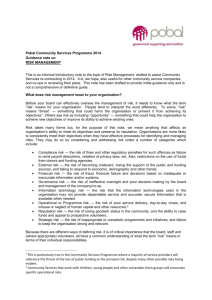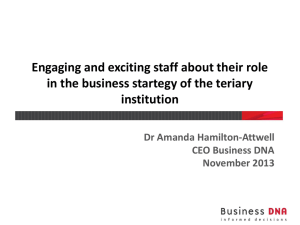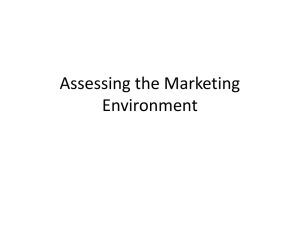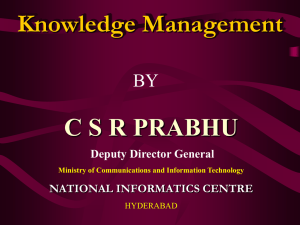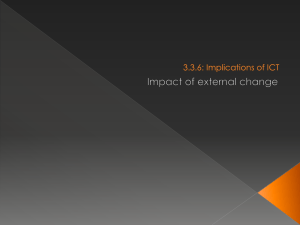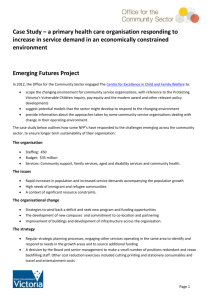BSBWOR502B
advertisement
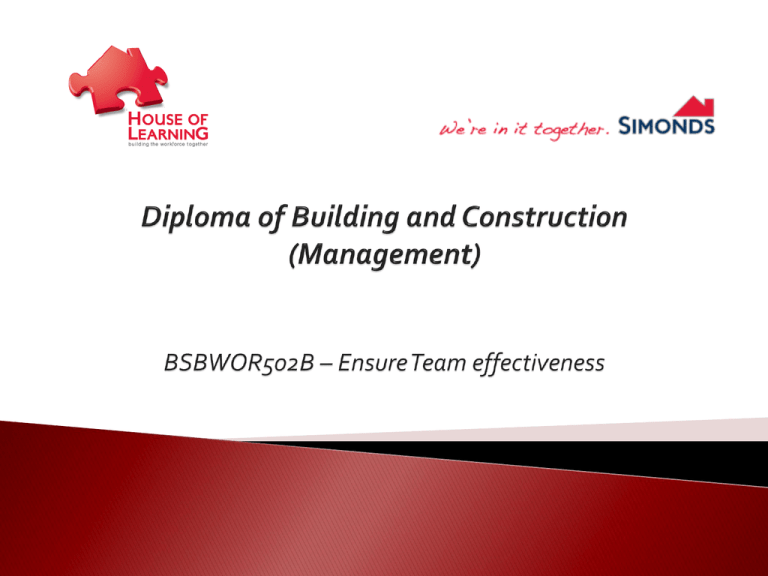
Establish Team performance plan Develop and facilitate team cohesion Facilitate team work Liaise with Stakeholders People come together in lots of ways: Collection: individuals with no sense of identity or team spirit is at one end of the scale. A work group or team; with common goals and a sense of identity. Individual contributors may work independently A team with shared goals, and independent team whose members share common goals a sense of purpose and identity. Members need to work together to reach their goals. Well led teams can achieve cost effective savings and remarkable gains in productivity, innovation and responsiveness to customer needs. Organisations that have introduced team based operations report over 40% gains in productivity and improved customer responsiveness, and manufacturing and design flaws cut by half. Where are we going ? Mission Statement A mission statement is a written organisational statement that states your organisation’s purpose and inspires and motivates your employees. Vision Statement A vision statement takes the mission statement one-step further and looks into your desired future for the organisation. Where are we going ? Objectives and Goals The objectives or goals are not something that is going to be written, and then simply left to gather dust. They are living, breathing document that must be referred to constantly throughout the operation of your team and organisation SMARTT Specific (Clear - Concise) Measurable Ambitious (achievable yet challenged) Related to overall departmental goals Time-framed Trackable Self Managed Teams: When work teams are empowered to make their own decisions, manage their own budget and organise their work and the resources they need, reorganise work systems and work flows, select their own team members and so on. Virtual Teams: Different locations, technology enables them to communicate easily and work on documents in real time. By knowing the SMARTT of your job role you will endeavour to achieve your goals, targets and KPI’s. K.P.I’s (Key Performance Indicators) The key performance indicators (KPIs) identify the purpose and importance of the actual job functions in achieving the purpose. Supporting the Team Openness Honesty Productivity Co-operation Information Clear Complete End User Feedback Promises Made / Promises Broken In every organisation, smaller groups form, made up of departments, work groups and networks. Each of these groups have subcultures or an operating code, its own common language, dress, rituals, ‘hangouts’ and performance expectations. Activity # 1 List six things that spring to mind when you think about your department or work group. How do people behave in your work group? Strategies Ask for input Engage in reflecting listening Greet employees when you see them Make an effort to get to know team members Provide forums for information Establish eye contact Recognise employees for their contribution Schedule regular meetings Show team members their opinions count Consider supervisor’s ‘like gold’ • Poor performing teams • High performing teams • In personal danger • Energetic • Low self esteem • Enthusiastic • Low team identity • Mutual trust • Poor team image • Secure • Threatened • Sense of fun • Strong identity Feelings Feelings •Low performing teams •High performing teams •Blaming •Decisions are put off •Active listening focuses on solutions •Game playing •Open and honest •Infighting •Respect for individuals •Lack of cooperation •Self-discipline •Some members withdrawing •Win-win approach •Personality clashes •Energies Behaviours Behaviours •Low performing teams •High performing teams •Dominate leadership •Camaraderie •Hidden agendas •Creativity •Lack of enjoyment •Empathetic relationships •Stereotyping •Enjoyment •Poor results •Mutual acceptance •Poor team spirit •Task achievement •Stress •Healthy Team Spirit Results Results Process The way a group of people work together, including absence or presence of tension, communicating patterns and style, group norms, and level of participation. When we pay too much attention to the task and leave the way the team works together to languish, the task itself ends up suffering. Process has dramatic influence on task achievement. It is the oil that keeps the team wheel turning. How clearly and openly team members communicate with each other, how enjoyable and supportively they work together, and how much they trust each other sets the stage for how they share ideas and innovation. Policies Develop policies to ensure team members take responsibility for their own work. Attend all meetings Attend training Agendas Keep team informed Feedback List of duties and responsibilities Work to build effective communications Feedback Feedback matters. The only way for people to get better at what they do is for the people they work for to provide candid, timely performance evaluations. In today’s environment, you have to evaluate what’s changing and what’s staying the same, what’s working and what’s no longer working. Feedback Feedback matters. The only way for people to get better at what they do is for the people they work for to provide candid, timely performance evaluations. In today’s environment, you have to evaluate what’s changing and what’s staying the same, what’s working and what’s no longer working. Feedback Always get feedback on your feedback One reason candid feedback is so important is that most people are great at self- delusion. It’s easy to think we are better at giving feedback than we are. There’s such a disconnection between managers ‘impressions of the feedback they give and their employees ‘ impressions of the feedback they get. Most managers need a reality check. Time to discuss these questions : How do we measure our teams success in working together and achieving results? How do we celebrate our success? How do we want to communicate with each other? How do we want to work with each other, individually or as a team? Do we wish to meet with each other and brain storm concepts? What makes it worthwhile for each of us to be part of a team? What must we do to achieve the team goals? Tasks The work an individual or a team carries out to achieve its goals and objectives Knowing each others roles and your own allows the team to work together and support each other in the achievement of their roles and tasks. You can increase the teams task commitment by involving them in the planning, decision making and other operational aspects of their work. The task refers to the goals the team is working to achieve, ensuring that every person is clear on what to do How leaders see their role : “I work to build a team that works well together and helps each other out. I want them to respect each other, trust each other and innovate and I want them to have fun whilst doing it!” “ I think it is important to emphasise the positive. To ‘catch people doing something right’ as they say” “ I work with my team. We work together to get the job done, solve problems, make decisions and so on. I oversee the process but, basically, the way I see it is: “We’re all in this together!” “We’re in it together” is Simonds company motto and culture. In groups discuss what this means to you and how you would describe how your leader see’s their role within the organisation and how does this motivate or impact your job role? Task needs: The need to succeed in reaching set goals- achieving a task Team needs: The need for the group to work as a team – building the team Individual needs: the need to feel satisfied with your own work, developing and motivating individuals Overlapping needs Task needs Team needs Individual needs Teams can also speed up the decision making process, increase efficiency in other ways, as well as reduce costs due to fewer layers of management interaction. Teams are an excellent way to benefit from people’s skills and knowledge. They can increase morals, stimulate innovation and improve job satisfaction by providing people with more control over their jobs and satisfaction of working collaboratively with others. Managed Teams: Managers form the organisations key functions and make up management or leadership teams. These teams coordinate work and strategy across the organisation. Matrix Teams: Designed so that employees are members of two or more teams. Each made up of different members from different functions. Members of Matrix teams report to different managers for each aspect of their job. Merged Teams: Acquisitions, mergers and takeovers are common. Employees from once competing organisations are asked to work together cooperatively for the good of the newly combined company. Mixed Teams: Full-time, part-time and casual workers, temporary and contract employees and off site employees make up mixed teams. Leading teams of various groups of workers presents special challenges for managers Multi-functional or cross – functional teams: Include people from various functions of an organisation and are responsible for delivering an entire product or service, from design to manufacture, marketing, delivery and after sales service, or for undertaking a special project such as developing and designing a new product. Their members often report to their team or project manager as well as a manager. Problem – Solving and Innovation Teams : Popular type of temporary team made up of knowledgeable people who meet to solve a specific problem, often through innovation, and then disband. Project Teams: Another type of temporary team brought together to undertake a specific assignment, such as launch a new product, design a new procedure or system or to introduce a new technology. Project teams are generally chosen across the organisation. Characteristics of a Team There must be an awareness of unity on the part of all its members. There must be interpersonal relationships. Members must have a chance to contribute, learn from and work with others. The members must have the ability to act together toward a common goal. Well functioning team Purpose: Members proudly share a sense of why the team exists and are invested in accomplishing its missions and goals. Priorities: Members know what needs to be done next, by whom, and by when to achieve team goals. Roles: Members know their roles in getting tasks done and when to allow more skillful member to do a certain task. Decisions: Authority and decision-making lines are clearly understood. Conflict: Conflict is dealt with openly and is considered important to decision-making and personal growth. Well functioning team Personal traits: Members feel their unique personalities are appreciated and well utilised. Norms: Group norms for working together are set and seen as standards for everyone in the groups. Effectiveness: Members find team meetings efficient and productive and look forward to this time together. Success: Members know clearly when the team has met with success and share in this equally and proudly. Training: Opportunities for feedback and updating skills are provided and taken advantage of by team members. Effective team Contribute ideas and solutions. Recognise and respect differences in others. Value the ideas and contributions of others. Listen and share information. Ask questions and get clarification. Participate fully and keep your commitments. Have fun and care about the team and the outcomes. High performance team Participative leadership Shared responsibility Aligned on purpose High communication Future focused Focused on task Creative talents Rapid response Resolving problems The reasons these problems may be occurring can include: Lack of skills and/or knowledge Miscommunication of information Staff not coping with workload Equipment failure Personal issues Tension within the team Resolving problems Ideas : Regular equipment maintenance and/or investing in new equipment Suggesting counselling for staff who have personal issues – or even scheduling some time off for them. Acting as a mediator to resolve issues between staff. If you expect a standard of behaviour in the workplace from your team they should be able to expect the same form you in return. Resolving problems Ideas : Staff training – either as a group or individuals Analysing your current communication channels – are they effective? What is the best method of getting the correct message to your team? Looking at staff workloads – are they over-loaded or is a lack of skill causing the problem? Stakeholder management is an important discipline that successful people use to win support from others. It helps them ensure that their projects succeed where others fail. The benefits of using a stakeholder-based approach are that: You can use the opinions of the most powerful stakeholders to shape your projects at an early stage. Gaining support from powerful stakeholders can help you win more resources – this makes it more likely that your projects will be successful. By communicating with stakeholders early and frequently, you can ensure that they fully understand what you are doing and understand the benefits of your project – this means they can support you actively when necessary. The benefits of using a stakeholder-based approach are that: You can anticipate what people’s reaction to your project may be, and build into your plan actions that will win people’s support. Identify stakeholders Prioritise stakeholders Understand key stakeholders You now need to know more about your key stakeholders. You need to know how they are likely to feel about and react to your project. You also need to know how best to engage them in your project and how best to communicate with them. Understand key stakeholders Key questions that can help you understand stakeholders are: What financial or emotional interest do they have in the outcome of your work? Is it positive or negative? What motivates them most of all? What information do they want from you? How do they want to receive information from you? What is the best way of communicating your message to them? Unresolved issues As a leader of people you may not be able to resolve every issue. Workplace issues, concerns or problems that remain unresolved need to be communicated through the correct channels to the correct people. These may include: Line managers Human resource department Union representatives Other stakeholders ASSESSMENT Images from Google





